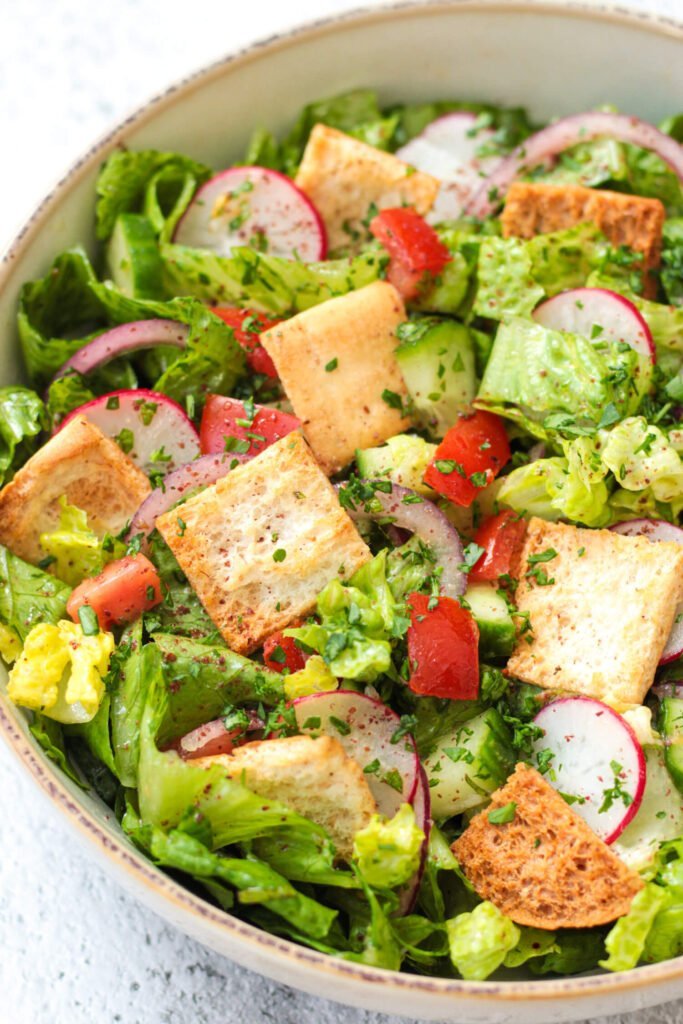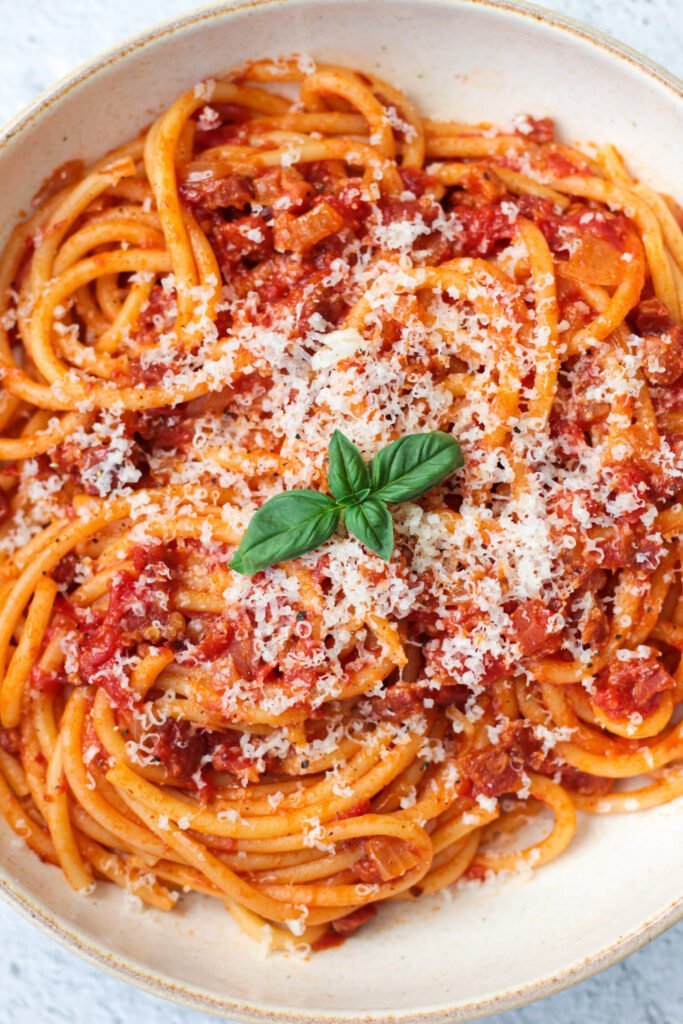Fattoush Salad is a refreshing and flavorful Mediterranean salad that is perfect for any occasion. It is a popular salad in Lebanon and other parts of the Middle East, and it is known for its unique combination of crunchy pita bread, seasonal vegetables, and tangy dressing.

Why this recipe works
Fattoush salad is a classic Middle Eastern dish that has gained immense popularity worldwide for its refreshing and nutritious qualities. This recipe brings together a perfect balance of fresh vegetables, herbs, and toasted pita bread, all dressed in a zesty and tangy dressing. The salad is bursting with different textures and flavors that complement each other perfectly, making every bite a delicious experience. The addition of sumac, a spice commonly used in Middle Eastern cooking, lends a subtle citrusy and earthy flavor to the dressing, making it truly unique. This salad is perfect for any occasion, whether it’s a quick weekday lunch, a party, or a family gathering. It’s easy to make, refreshing, nutritious, and delicious, making it a crowd-pleaser every time.
What is Fattoush Salad
Fattoush salad is a popular Middle Eastern salad that originated in Lebanon. It is a colorful and refreshing salad that consists of a variety of fresh vegetables, herbs, and toasted pita bread, all tossed in a tangy dressing. The salad is a staple in Lebanese cuisine and is enjoyed by people all over the world.
The name Fattoush comes from the Arabic word fatteh, which means crumbs or pieces. This refers to the toasted pita bread that is broken into small pieces and added to the salad. The salad has a long history, dating back to ancient times when it was a staple food of the Levantine region. Over time, the recipe evolved, and different variations emerged in different parts of the Middle East.

Best ingredients for Lebanese Fattoush Salad
- Pita bread: Use a large pita bread for this recipe. Toasting it in the oven will give it a nice crunch.
- Romaine lettuce: The crisp texture and mild flavor of romaine lettuce make it the perfect base for Fattoush Salad. It is high in fiber, vitamins, and minerals, making it a healthy addition to any diet.
- Tomatoes: Tomatoes are a key ingredient in Fattoush Salad, providing a juicy and flavorful addition to the salad. They are a rich source of lycopene, an antioxidant that has been linked to improved heart health and reduced risk of cancer.
- Cucumber: Cucumbers add a refreshing crunch to the salad and are also high in water content, making them hydrating and refreshing.
- Radishes: Radishes add a spicy kick to the salad and are a great source of vitamin C and other important nutrients.
- Red onion: Red onion provides a mild yet sweet flavor to the salad and is also a good source of fiber and antioxidants.
- Parsley and mint: These fresh herbs add a bright and zesty flavor to the salad. They are also rich in antioxidants and have been linked to improved digestion and reduced inflammation.
- Olive oil: Extra-virgin olive oil is a key ingredient in the dressing, providing a healthy source of monounsaturated fats and antioxidants.
- Lemon juice: Lemon juice provides a tangy and refreshing flavor to the dressing and is also a rich source of vitamin C.
- Sumac: Sumac is a tangy and lemony spice that is commonly used in Middle Eastern cuisine. It adds a unique flavor and tanginess to the dressing, making it a key ingredient in Fattoush Salad.
How to make Fattoush Salad
Please note: This is just an overview – the full ingredients and directions are in the recipe card at the bottom of this post.
Step 1: Toast the pita bread
Preheat the oven to 375°F (190°C). Cut the pita bread into small pieces and place them on a baking sheet. Toast in the oven for 10-12 minutes, until crispy and golden brown.
Step 2: Combine ingredients
In a large salad bowl, combine the chopped romaine lettuce, tomatoes, cucumber, radish, red onion, parsley, and mint.
Step 3: Make the dressing
Whisk together the lemon juice, olive oil, garlic, sumac, salt, pomegranate molasses, and pepper in a small bowl. Pour the dressing over the salad and toss well to combine.
Step 4: Assemble the salad
Add the toasted pita bread to the salad and toss again. Serve immediately and enjoy!



Storing tips
Lebanese Fattoush Salad is best served immediately after tossing to prevent the pita bread from getting soggy. However, if you have any leftovers, you can store the salad in an airtight container in the refrigerator for up to 2 days.
Keep in mind that the salad may become a bit soggy if stored for an extended period of time, especially due to the moisture from the vegetables. To freshen up the salad, you can add a bit of extra olive oil, lemon juice, and salt before serving. Avoid storing the salad with the toasted pita bread, as it will lose its crispiness. Instead, keep the bread separately and add it to the salad just before serving.
Top tips for the best Lebanese Fattoush Salad
- Use fresh ingredients: The flavor and texture of the salad will greatly depend on the freshness of the ingredients. Make sure to use crisp lettuce, ripe tomatoes, and firm cucumbers for the best results.
- Toast the pita bread: Toasting the pita bread in the oven before adding it to the salad will give it a nice crunch and prevent it from getting soggy.
- Use sumac for authentic flavor: Sumac is a tangy, lemony spice commonly used in Middle Eastern cuisine. It adds a distinctive flavor to the salad and is a key ingredient in traditional Lebanese Fattoush Salad.
- Add the dressing just before serving: To prevent the salad from becoming soggy, add the dressing just before serving and toss the salad well to distribute the flavors.
- Customize to your liking: While the recipe for Lebanese Fattoush Salad is traditional, you can easily customize it to suit your taste preferences. Try adding other vegetables like bell pepper, green onions or carrot.

You may also enjoy…
Chicken Parmesan Pasta with Gremolata
FAQ
Can I make Fattoush Salad in advance?
It’s best to make the salad just before serving to prevent the pita bread from getting soggy. However, you can prepare the ingredients in advance and store them separately in airtight containers until you’re ready to assemble the salad
Can I substitute the sumac with another spice?
If you can’t find sumac, you can substitute it with lemon zest for a similar flavor profile.
Can I use a different type of lettuce?
Romaine lettuce is traditionally used in Lebanese Fattoush Salad, but you can use other types of lettuce if you prefer. Just make sure to use a crisp and sturdy variety so that it holds up well in the salad.
Is Fattoush Salad vegan?
Yes, this recipe for fattoush salad is vegan as it doesn’t contain any animal products.
Did you make it?
I would love to hear about your experience in the comments below!
Your feedback is valuable and helps me to continue creating delicious recipes that you will love.
So, don’t be shy, leave a comment and let me know how it turned out for you!
Don’t forget to mention @goodfooddiscoveries or tag #goodfooddiscoveries on social media.
I’d love to see your remakes!








One Comment